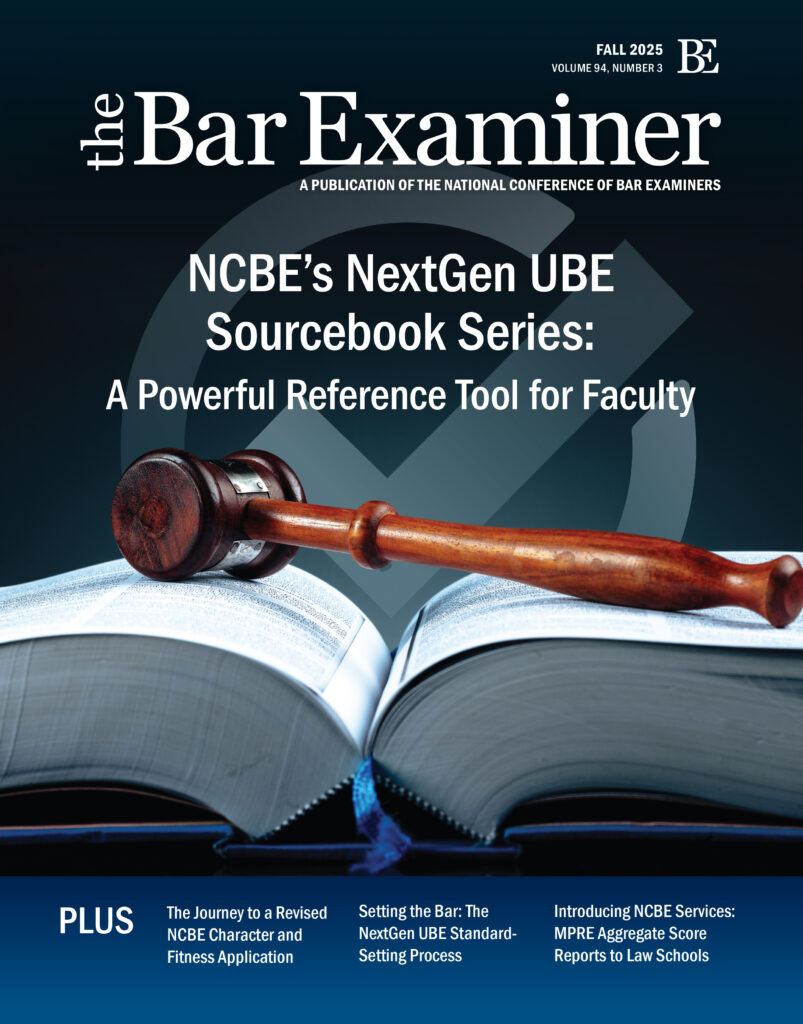This article originally appeared in The Bar Examiner print edition, Summer 2019 (Vol. 88, No. 2), pp 21–23.
By Gregory G. Murphy

The Council of the Section of Legal Education and Admissions to the Bar of the ABA adopts and applies law school accreditation standards with which law schools must demonstrate compliance. Effective May 2019, the Council revised one of the most important “outcomes” standards, Standard 316, sometimes called the Bar Passage Standard. Standard 316 now states:
At least 75 percent of a law school’s graduates in a calendar year who sat for a bar examination must have passed a bar examination administered within two years of their date of graduation.
Prompted by a concern about the high cost of a legal education, the student loan debt levels of at-risk students, and declining bar passage rates, and following years of hearings and comments, the Council initially adopted, subject to ABA House of Delegates concurrence, the revision to Standard 316 in October 2016. The ultimate adoption of the revised Standard, however, was not without controversy. Indeed, the ABA House of Delegates twice overwhelmingly declined to approve the revisions.1 Nevertheless, as the final authority on the Standards, the Council finally adopted the revised Standard 316 at its May 2019 meeting.
A Brief History of Standard 316
Law School Compliance Prior to Standard 316
The source for Standard 316 lies in Standard 301, Objectives of Program of Legal Education, which provides that
(a) A law school shall maintain a rigorous program of legal education that prepares its students, upon graduation, for admission to the bar and for effective, ethical, and responsible participation as members of the legal profession.2
How does the Council measure whether a law school is operating in compliance with Standard 301? Schools have long reported bar admissions data to the Section. For decades, if a school’s first-time bar passage rate—the rate at which its graduates passed a bar examination on the first attempt—fell below 75%, the Section’s Accreditation Committee3 would write to the school saying that the Committee had reason to believe that the school was not operating in compliance with Standard 301 and request that the school report back to the Committee on what it was doing to bring itself into compliance.
There were a couple of serious problems with the 75% rule and how it was being applied by the Accreditation Committee. First, the “rule” was not published, hindering a universal knowledge and understanding of the rule. Second, the lack of specificity and time frame for compliance meant that the Accreditation Committee found itself asking cited schools to continue to report back to the Committee for years in cases of persistent noncompliance, on some occasions even longer than the then-seven-year site inspection cycle.4
Standard 316 Is Born
To address these issues, an “Interpretation” of Standard 301 was published, and eventually a separate standard, Standard 316, was adopted. Standard 316 explicitly stated that a school could demonstrate compliance with Standard 301(a) in one of two ways:
(1) That for students who graduated from the law school within the five most recently completed calendar years:
(i) 75 percent or more of these graduates who sat for the bar passed a bar examination; or
(ii) in at least three of these calendar years, 75 percent of the students graduating in those years and sitting for the bar have passed a bar examination.5
(In so demonstrating, the school was required to report bar passage results from as many jurisdictions as necessary to account for at least 70 percent of its graduates each year, beginning with the jurisdiction in which the largest number of graduates took the bar exam and continuing in descending order of frequency.)
(2) That in three or more of the five most recently completed calendar years, the school’s annual first-time bar passage rate in the jurisdictions reported by the school is no more than 15 points below the average first-time bar passage rates for graduates of ABA-approved law schools taking the bar examination in these same jurisdictions.6
(This second method also required the same level of reporting on 70 percent of graduates each year as with the first method. When more than one jurisdiction was reported, the weighted average of the results in each of the reported jurisdictions was to be used to determine compliance.)
The Standard went on to describe eight different ways of demonstrating “good cause” to have the two-year compliance deadline extended.7
In both theory and practice, the old Standard 316 described above proved to be problematic. Its structure, particularly the five-year calculation period, delayed the Accreditation Committee and the Council from taking effective action, and in practice the Standard was not a uniform national standard.
Revised Standard 316
The new Standard 316 has the virtue of simplicity in measurement and calculation. While the ultimate passage rate of 75% is unchanged, the revisions reflect important changes to how law school compliance is measured.
- The period for showing compliance is shortened from five years to two. The two-year measuring period was chosen because data from NCBE has demonstrated that the persistence rate (continuing to attempt to pass a bar examination after failing) drops precipitously after two failed attempts. After four failed attempts, it is negligible.8
- The requirement that a school need only report on 70% of its graduating class has been struck, providing a more accurate picture of how the school’s graduates are performing on the bar exam.
- The opportunity for a school to show compliance by demonstrating that its first-time passage rate in the jurisdictions in which its graduates took the bar exam is within 15 points of the overall first-time passage rate in those jurisdictions has been eliminated, ensuring that compliance is based solely on the ultimate pass rate for the school’s graduates who sat for the exam.
How many law schools will find themselves struggling to comply with the new Standard 316? Current data suggests that even if schools make no changes, a relatively small number of schools out of the over 200 accredited institutions may struggle.9
The arguments against revised Standard 316 tended to be motivated by a concern that the new Standard may deter law schools from admitting students with lower entering credentials, which are often those most underrepresented in the profession; by a concern that it might place an additional burden on law schools to collect data; and by uncertainty over how the revised Standard would affect law schools in jurisdictions with high cut scores.
In response, the Council noted that there is no evidence indicating that law schools would allow a bar passage standard to affect their commitment to diversity (furthermore, the Council has measures in place to ensure that law schools function in an inclusive and nondiscriminatory manner), that any efforts needed to collect additional data are reasonable given the importance of bar passage information, and that the ultimate goal of the Standard is to protect students and the public.
Few argue that it is acceptable for more than 25% of a law school’s graduates to devote three years of time and effort, not to mention many thousands of dollars, and not be admitted to the practice of law.
What Are the Implications?
As stated by Barry Currier, Managing Director for the ABA Section of Legal Education and Admissions to the Bar, “These revisions provide more straightforward and clear expectations for law schools, and establish measures and process that are more appropriate for today’s environment. Most students go to law school to become lawyers. Becoming a lawyer requires passing the bar exam. How well a school’s graduates perform on the bar exam is a very important accreditation tool to assess the school’s program of legal education.”10
What impact will the revised Standard 316 have on the work of bar examiners and bar admission administrators? In the near-term future, little will change in bar admissions as a result of the revisions. A bar examiner might ask, “Are we going to see fewer graduates from ABA-approved law schools because there will be fewer schools?” That is unlikely, at least in any material way. While the revised Standard is effective immediately, a school would be unlikely to be subjected to adverse action until at least two years after being found out of compliance. If a proposed new rule revising accreditation regulations is adopted by the U.S. Department of Education,11 that two-year time period would be eliminated and replaced by a requirement for the school to develop a written timeline for bringing itself into compliance. That timeline might, if approved, extend beyond two years. Also, as noted above, data suggests that a relatively small number of schools might struggle as a result of the new Standard.12 Moreover, one might expect those schools not to remain complacent, but to react, by altering their admissions policies and protocols, their programs of education, or both, with salutary effects on their bar passage outcomes. In short, other events and forces affecting bar admissions are likely to have larger impacts on the work of bar examiners and bar admission administrators.
Notes
- Under the rules, a proposed standard must be submitted to the ABA House of Delegates for consideration. If the House concurs, the Standard becomes effective. If not, then the Standard goes back to the Council for deliberation. The Council may decide to resubmit the proposed Standard to the House, amend the Standard and submit the amended Standard to the House (starting a new cycle), or not resubmit the Standard to the House—at which point, if the Council once again confirms the changes it had adopted, the decision of the Council stands without further House review. The Council is the final authority on the Standards. (Go back)
- ABA Section of Legal Education and Admissions to the Bar, ABA Standards and Rules of Procedure for Approval of Law Schools 2018–2019 (American Bar Association, 2018), available at https://www.americanbar.org/groups/legal_education/resources/standards/. (Go back)
- For many years, the Accreditation Committee of the ABA Section of Legal Education and Admissions to the Bar reviewed site inspection reports and conducted hearings relating to compliance with the accreditation Standards. Effective August 2018, the functions of the Accreditation Committee were assumed by the Section Council. (Go back)
- Per the ABA Standards and Rules of Procedure for the Approval of Law Schools, all fully and provisionally ABA-approved law schools are subject to periodic site inspection visits organized by the ABA Section of Legal Education and Admissions to the Bar. While the cycle for site visits to fully approved law schools was previously every seven years, the current cycle is every tenth year. (Go back)
- ABA Section of Legal Education and Admissions to the Bar, supra note 2. (Go back)
- Id. (Go back)
- The U.S. Department of Education regulations require a recognized accreditor to take “adverse action” against a school, meaning remove it from the approved list, if the school does not bring itself into compliance within two years of being cited for being out of compliance, unless good cause is shown. In June 2019, the U.S. Department of Education issued a proposed rule revising the accreditation regulations, one feature of which would be to remove the two-year compliance deadline and replace it with a rule requiring an accreditor to require a school to provide a written timeline for coming into compliance that is “reasonable” based on the nature of the finding of noncompliance and the education objectives of the program of education and the institution. (Go back)
- As the readers of this magazine know, throughout the country the bar examination is administered twice a year (except in Delaware, which does not administer a February bar exam), affording four opportunities within two years. [Editor’s Note: For a previous article presenting data on the number and percentage of examinees taking the MBE one or more times, see Erica Moeser, “President’s Page,” 85(3) The Bar Examiner 4–7 (September 2016).] (Go back)
- See the data presented in “Statement from Barry Currier, Managing Director for the ABA law school accreditation process, regarding Council revision of Standard 316 of the ABA Standards and Rules of Procedure for Approval of Law Schools,” available at https://www.americanbar.org/content/dam/aba/administrative/legal_education_and_admissions_to_the_bar/may-17-2019-barry-currier-statement-on-standard-316.pdf. (Go back)
- “Statement from Barry Currier, Managing Director for the ABA law school accreditation process, regarding Council revision of Standard 316 of the ABA Standards and Rules of Procedure for Approval of Law Schools,” available at https://www.americanbar.org/content/dam/aba/administrative/legal_education_and_admissions_to_the_bar/may-17-2019-barry-currier-statement-on-standard-316.pdf. (Go back)
- Supra note 7. (Go back)
- Supra note 9. (Go back)
 Gregory G. Murphy was elected to the Council of the ABA Section of Legal Education and Admissions to the Bar in 2010. He served as chair of the Council from 2016 to 2017. He also served upon and as chair of the Section’s Accreditation Committee. Murphy is a former longtime chair of the Montana Board of Bar Examiners. He chaired the NCBE Board of Trustees from 2000 to 2001.
Gregory G. Murphy was elected to the Council of the ABA Section of Legal Education and Admissions to the Bar in 2010. He served as chair of the Council from 2016 to 2017. He also served upon and as chair of the Section’s Accreditation Committee. Murphy is a former longtime chair of the Montana Board of Bar Examiners. He chaired the NCBE Board of Trustees from 2000 to 2001.
Contact us to request a pdf file of the original article as it appeared in the print edition.








